What Is Bigfoot?
Posted by: Loren Coleman on June 17th, 2008
Of the routine and infrequent fossil candidates submitted for consideration as to the origins of Bigfoot/Sasquatch, which one is your favorite?
I begin with the premise that this unknown, yet-to-be-verified, hairy bipedal hominoid is an actual biological species. Getting beyond the argument of whether or not Bigfoot exists, what do you think might be the fossil candidate best matching the sightings and evidence of the classic Patterson-Gimlin Bigfoot, Patty, and the specimens seen during encounters aligned with her, from the Pacific Northwest of the USA and Canada?
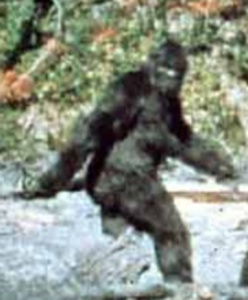
The reconstructions of William Munns give some new views of how these fossil hominoids appeared and how they may be seen in terms of Patty or Sasquatch, in general.

Bill Munns works on the Gigantopithecus head.

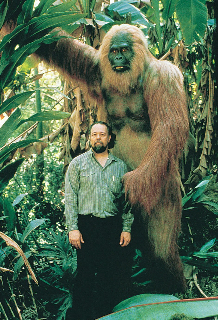
Bill Munns’s now-famous bipedal version of Gigantopithecus.
The fossil recreation work of Bill Munns on Gigantopithecus is often-cited in works on Sasquatch, because the books of leaders in the field, such as Grover Krantz and Jeff Meldrum, both anthropology professors, have promoted Gigantopithecus as their candidate of choice.
The above and following images of Gigantopithecus show Munns’s excellent work on this great ape.
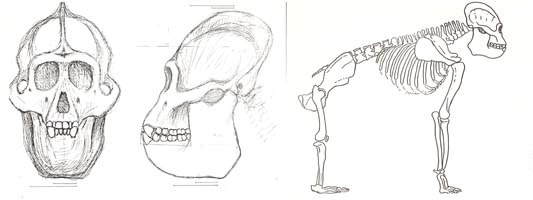
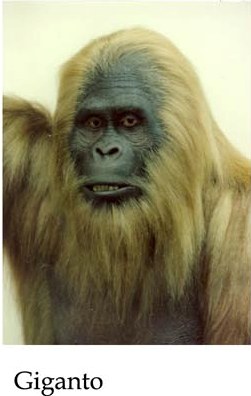
In 2007, at the American Museum of Natural History’s exhibition on Mythic Creatures, one of the highlights was the corner they set aside for unknown hairy hominoids. They used their in-house model (below) of Gigantopithecus ~ designer unknown ~ to demonstrate what they felt Yeti looked like. This new view of Giganto, less bipedal and more apelike, is coming into its own.
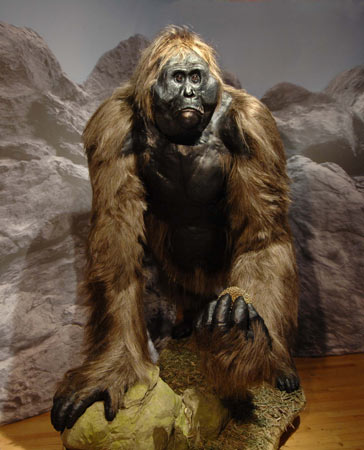
The AMNH’s Gigantopithecus model was large and Yeti-like and gives us much to ponder.
Back to Bigfoot…
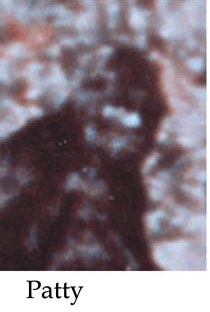
Patty’s head.
Of course, the major problem with Gigantopithecus as a candidate for Bigfoot is that the ape may be an anthropoid both too large and not bipedal. Gigantopithecus is, of course, only known from a handful of mandibles and a thousand teeth from India, China, and Indochina. Bill Munns has pointed out too that “Giganto seems to have a rather tall vertical face.”
Munns also has noted that while he feels that Giganto may have the correct size for Bigfoot, it has the drawbacks of needing to explain a second bipedal evolution event and the evolution back to a low cranium.

Besides Gigantopithecus, the other major fossil candidate for Bigfoot is Paranthropus, which, as the above skull demonstrates, has a prominent sagittal crest. I have never hidden the fact that my bias is in the direction of Paranthropus, because here we have a hominoid that was already bipedal, about the right size (remember Patty was only 6.5 feet tall), probably hairy, and had that beautiful sagittal crest in both males and females.
Few people have known that William Munns has also reconstructed some rather fine examples of Paranthropus specimens.

Paranthropus aethiopicus (above and below) is the name of the hyper-robust hominid fossil based on the “Black Skull” or “KNM WT – 17000.” For this Paranthropus to become Patty, this species would have to grow taller, have the brow ridges expand, and reduce the projection of the mouth. The bipedalism and sagittal crest are already there.
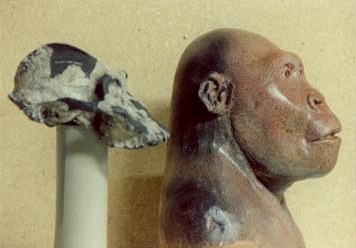

Another reconstruction by Bill Munns shows another Paranthropus. The following are images of Paranthropus boisei, first called Zinjanthropus or “Zinj” found at Olduvai Gorge by the Leakeys. This robust Australopithecine was bipelal, had a sagittal crest, and a short face not unlike Patty’s. Munns observes that two relatively easy evolutionary adjustments, larger size and bigger brow ridges, would have to occur to have this Paranthropus more directly match Patty.
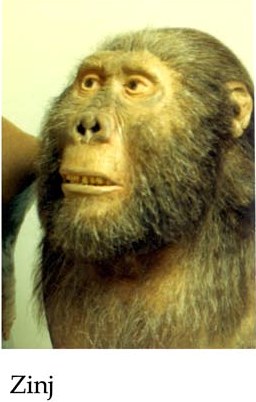
Munns has written: “If we were to apply Ockham’s Razor to the question of Patty’s fossil heritage, the solution with the least complicated conditions would actually be Zinj.”
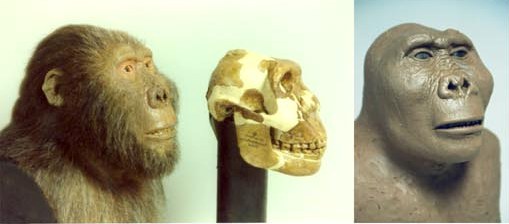
How did Paranthropus get from Africa through Asia to the Pacific Northwest without any fossil evidence being left behind?
I once again, point to Meganthropus palaeojavanicus.
In Southeast Asia, during the 1940s, paleoanthropologists Franz Weidenreich and Ralph von Koenigswald found evidence, generally ignored by anthropologists, that Gigantopithecus (the very strong and enormous anthropoid ape), Meganthropus palaeojavanicus (the great man of ancient Java, known by some today as Paranthropus), and two different species or subspecies of Homo erectus (namely the so-called Java apeman and the Peking man), all lived at the same time in that corner of the globe.
Meganthropus are assigned to Paranthropus by some mainstream anthropologists, although others assign Meganthropus to Homo erectus. In the 1940s, Meganthropus was popularly called the “Great Man of Ancient Java” and was said to reach heights of 8 feet and 3 inches (Giant by P. J. Lee, London: Yoseloff, 1970, page 30). Franz Weidenreich found the Asian Meganthropus mandibles massive, and frequently called it the “Java Giant,” (Apes, Giants, and Men, Chicago: University of Chicago Press, 1946).
Meganthropus africanus was later assigned to Paranthropus robustus.
This is only my sense of the landscape, but to me:
Parathropus, traveling through Asia into the Americas, remains a valid fossil candidate for the great bipedal forest giant, Sasquatch/Bigfoot of the Pacific Northwest of the Americas.
Gigantopithecus, found throughout South Asia, remains a valid fossil candidate for the great rock ape, Yeti of the Himalaya, in Nepal, Tibet, Mustang, Bhutan, and northern India.
My sincere appreciation to William Munns for sharing his fossil reconstructions and his thoughts on these fossil candidates and how they match up to Patty.
About Loren Coleman
Loren Coleman is one of the world’s leading cryptozoologists, some say “the” leading living cryptozoologist. Certainly, he is acknowledged as the current living American researcher and writer who has most popularized cryptozoology in the late 20th and early 21st centuries.
Starting his fieldwork and investigations in 1960, after traveling and trekking extensively in pursuit of cryptozoological mysteries, Coleman began writing to share his experiences in 1969. An honorary member of Ivan T. Sanderson’s Society for the Investigation of the Unexplained in the 1970s, Coleman has been bestowed with similar honorary memberships of the North Idaho College Cryptozoology Club in 1983, and in subsequent years, that of the British Columbia Scientific Cryptozoology Club, CryptoSafari International, and other international organizations. He was also a Life Member and Benefactor of the International Society of Cryptozoology (now-defunct).
Loren Coleman’s daily blog, as a member of the Cryptomundo Team, served as an ongoing avenue of communication for the ever-growing body of cryptozoo news from 2005 through 2013. He returned as an infrequent contributor beginning Halloween week of 2015.
Coleman is the founder in 2003, and current director of the International Cryptozoology Museum in Portland, Maine.










Bill Munns-Thanks for the comments.
Bigfoot, as an evolved, larger Parathropus boisei, might have developed a larger sagittal crest since it would necessarily need more fuel to live. And this begs the question: what can we expect as to bigfoot diet, given Parathropus as a prototype or indeed as an ancestor.
Jerrywayne:
It isn’t so much the amount of “fuel” (food or nutrient) a body needs, so much as what kind it is and how much chewing it needs before swallowing. So eating an egg needs no real chewing, whereas eating walnuts does.
So essentially you just need to look for a reason to say paranthropus became a specialized herbivore instead of the general hominid presumption they were non-specialized omnivores.
So you might imagine that a paranthopus group traveled to a niche environment where nuts and very edible (but needing chewing) vegetation was plentiful and soft fruits, bird eggs, and small reptiles, lizards, etc. were more scarce. Then, if they settle into that niche, they may evolve a more developed sagital crest to accommodate the extra chewing each day.
Bill
For the sake of argument, let’s say we can settle on an evolved Paranthopus as the identity of bigfoot (of course, monster large and possessing a prominent sagittal crest, in keeping with Patterson’s subject). What then, can we deduce from taking this approach as a given? If bigfoot/paranthopus sustains itself on nuts and edible, tough vegetation (as we would expect from Patterson’s subject obvious crest), what kind of behavior would we then expect? A grazing type of animal, perhaps, one that does not need to travel wide? Based on what we see in other primates, would bigfoot be a social animal, living like gorillas or chimpanzees, within a group with an obvious social hierarchy? How does this bigfoot/paranthopus scenario play out against eyewitness testimony?
none the less it will be caught
amen?. 😀
i forgot what site, but i seen some pictures of what could be a Bigfoot, Yowi, yeti, A. Snowman, cryptid that’s not big foot, unknown species that’s no known in cryptozoology or living fossil.. but i looked legit….. well to me
i think it’s an ape. but very well can be a monkey..
apes are built except for chimpanzee their skinny.. and when i mean built i mean like gorillas and orangutans..
but i could be wrong it could be a monkey.
if it’s indeed a subspecies then wow what primate made that? 😀
and if it’s the original primate that started all the primates. wow lol..
but if Gorillas, Orangutans, Chimpanzee’s..etc. are related then i wonder where did the Gorillas, Orangutans, Chimpanzee’s originated from. 🙂 Cause i have a feeling Yowl, Bigfoot, yeti maybe resembles or have Characteristics of Apes instead of monkeys.
as far as i know.. from what i read.. no one mentioned an ape like characteristics
I believe in our present time were able to do more then what we expect.. i think were able to catch lots of cryptids, living fossils..etc.
but with patients unless they appear on the spot right away.
🙂 ;d amen amen.:)
if we don’t have patients and if we jump to conclusion we will be busting a “Destination Truth” (although i love that show) meaning that (if i remember correctly) when they were looking for the Mokele-Mbembe.. they didn’t see it, when their trip was over they said “it isn’t real”… that’s so lame… they can’t assume that just cause they didn’t see it… chances are you won’t see it when you want to, and chances are you will… and chances are you will see it when you don’t look for it. and chances are you will not.
i say if someone is going to do an expedition at least it should be for a week or 2 or more.. but if their able to stay for days it’s cool.. as long as they realize they may not see it…. if i go around my city hoping to see lizards (yes we have lizards “wild ones”) chances are i will not see one. And I won’t see one just cause i want to…and second their able to not be seen by us.. even if their small and have a big advantage of hiding lol… you get my point. 🙂
Too many of us jump to conclusions and not realizing the truth is right in front of our eyes.
i know for a fact that if see any spiders, insects and bugs we never seen before we ignore them or kill them.. without even realizing they may be a cryptid or living fossil or unknown species… who knows….
same goes with larger creatures not everybody seen and knows all recorded animals and they may assume the animal they saw is recorded or they will ignore it and walk away… without even realizing it was a living fossil or cryptid or unknown species of animals..etc.
i for sure seen a strange insect or bug or spider.. what ever it was.. in my bathroom although i had no batteries for my camera then.. so i couldn’t have tooken a picture. the only picture i have of it is in my head.
I, for one, know that BigFoot doesn’t look like a human.
To a degree? Possibly. But that’s only because the positions of the eye’s, nose and mouth, along with ears, are on the same places as humans are.
We’re talking jet-black skin on the face, and the nose looks almost human, but now quite certain.
The small size of forehead, the big brow ridge looks ape.
The size of animals can get up to around 9.5 to 10 foot.
Which of the candidates get that big?
The hands look chimpanzee-like, with a really long palm that shows the simian lines traveling straight across the palm, The thumb sets really far down at the bottom of the palm.
The cheek bones protrude out like a great ape.
And to be VERY honest, I believe that the problem with giving these “unknown” animals a positive ID is because there actually might be more than one type of up-right walking creature out there.
I’m pretty sure of it.